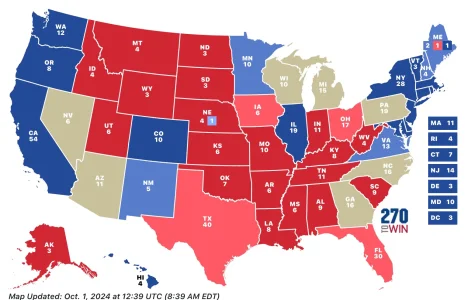American democracy is not without flaws but nobody is allowed to fault it although there are glaring flaws in its democratic process. Here in my short essay on how the American democracy works:
————-
The Deep Flaws in America’s Election Process
America’s election system has significant flaws. Citizens do not directly elect their leader, nor does the leader of the majority in Parliament automatically become president. Instead, the process is indirect, with each state selecting electors who cast votes for the president. In most states, the winner of the popular vote takes all the electors, with only Maine and Nebraska making exceptions. These electors ultimately determine the president. A glaring example of the system’s shortcomings occurred in 2016, when Hillary Clinton won the popular vote by over two million, but Donald Trump secured the presidency through the Electoral College.
Why Is It Like This?
The roots of this system trace back to the drafting of the Constitution after independence in 1776. The representatives from the 13 states who gathered in Philadelphia sought to ensure equal power among states, and the Constitution was written with this principle in mind. As a result, the president is elected not directly by the people, but by 538 electors—known as the Electoral College—who represent their respective states. Most states follow a winner-take-all system, except for Maine and Nebraska, where electoral votes are split.
Voters often struggle to grasp the intricacies of this system, especially the number of electors each state sends to the Electoral College. When the Constitution was written, the U.S. had just 13 states and a population of 2.5 million. Today, the nation has grown to 330 million people, and the number of electors is apportioned by state population. For example, California, the most populous state, has the most electors, while smaller states like Hawaii, Alaska, and Wyoming have fewer.
In the 48 states that use a winner-take-all system, much of the presidential campaign effort is concentrated—creating a strategic focus on just a few key states. The winner takes all, rewards the larger group and it also creates safe and battleground states distinction.
Despite this complicated process, the U.S. has managed to make the system work, which is a credit to its stability. Although court challenges have arisen throughout history, the system endures, and that consistency is worth appreciating.
Checks on Power
Although the president holds significant power, the framers of the Constitution implemented checks and balances. Most financial powers rest with the House of Representatives, where spending must be approved by directly elected representatives. Additionally, the Senate, made up of two representatives from each state, serves as a powerful advisory body to the president. This structure plays a key role in maintaining balance. Overseeing it all is the Supreme Court, which ensures the executive and legislative branches operate within the framework of the Constitution.
The Complexity of American Democracy
To outsiders, American democracy may seem complicated and at times flawed, but it continues to function. However, it has faced significant challenges, such as the events of January 6, 2021, when a mob questioned the peaceful transfer of power. Despite these tests, the system remains resilient.

America’s election system has significant flaws. Citizens do not directly elect their leader, nor does the leader of the majority in Parliament automatically become president. Instead, the process is indirect, with each state selecting electors who cast votes for the president. In most states, the winner of the popular vote takes all the electors, with only Maine and Nebraska making exceptions. These electors ultimately determine the president. A glaring example of the system’s shortcomings occurred in 2016, when Hillary Clinton won the popular vote by over two million, but Donald Trump secured the presidency through the Electoral College.
Why Is It Like This?
The roots of this system trace back to the drafting of the Constitution after independence in 1776. The representatives from the 13 states who gathered in Philadelphia sought to ensure equal power among states, and the Constitution was written with this principle in mind. As a result, the president is elected not directly by the people, but by 538 electors—known as the Electoral College—who represent their respective states. Most states follow a winner-take-all system, except for Maine and Nebraska, where electoral votes are split.
Voters often struggle to grasp the intricacies of this system, especially the number of electors each state sends to the Electoral College. When the Constitution was written, the U.S. had just 13 states and a population of 2.5 million. Today, the nation has grown to 330 million people, and the number of electors is apportioned by state population. For example, California, the most populous state, has the most electors, while smaller states like Hawaii, Alaska, and Wyoming have fewer.
In the 48 states that use a winner-take-all system, much of the presidential campaign effort is concentrated—creating a strategic focus on just a few key states. The winner takes all, rewards the larger group and it also creates safe and battleground states distinction.
Despite this complicated process, the U.S. has managed to make the system work, which is a credit to its stability. Although court challenges have arisen throughout history, the system endures, and that consistency is worth appreciating.
Checks on Power
Although the president holds significant power, the framers of the Constitution implemented checks and balances. Most financial powers rest with the House of Representatives, where spending must be approved by directly elected representatives. Additionally, the Senate, made up of two representatives from each state, serves as a powerful advisory body to the president. This structure plays a key role in maintaining balance. Overseeing it all is the Supreme Court, which ensures the executive and legislative branches operate within the framework of the Constitution.
The Complexity of American Democracy
To outsiders, American democracy may seem complicated and at times flawed, but it continues to function. However, it has faced significant challenges, such as the events of January 6, 2021, when a mob questioned the peaceful transfer of power. Despite these tests, the system remains resilient.






